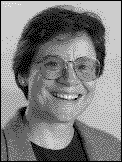From the Editor
 I
was at a social gathering of the 1998 International Pig Veterinary
Society when a colleague congratulated me on becoming the new
Executive Editor of the journal and then said "I guess you
will have to find another place to publish your work". To
be honest, it was not something that I had spent much time considering
when I applied for the position. I have alwaysseen the Journal
of Swine Health and Production (JSHAP) as the most
logical and rewarding journal for my research. I conduct practical,
applied field work and then hope that the information will be
disseminated to the widest possible audience. I believe that research
published in JSHAP reaches the field faster than research
published in any other journal because the readers are AASV members.
Members of AASV are the veterinarians who are actively involved
with swine producers on a daily basis.
I
was at a social gathering of the 1998 International Pig Veterinary
Society when a colleague congratulated me on becoming the new
Executive Editor of the journal and then said "I guess you
will have to find another place to publish your work". To
be honest, it was not something that I had spent much time considering
when I applied for the position. I have alwaysseen the Journal
of Swine Health and Production (JSHAP) as the most
logical and rewarding journal for my research. I conduct practical,
applied field work and then hope that the information will be
disseminated to the widest possible audience. I believe that research
published in JSHAP reaches the field faster than research
published in any other journal because the readers are AASV members.
Members of AASV are the veterinarians who are actively involved
with swine producers on a daily basis.
As Executive Editor of JSHAP, I was suddenly thrown into a conflict of interest position.I had several manuscripts in the journal pipeline. They had been reviewed and were just waiting for me to make the necessary editorial changes. I deliberated with Dr. Bob Morrison, Ruth Cronje (then Associate Editor) and Eileen Kuhlmann (then Managing Editor) about how to handle this blatant conflict of interest. Dr. Morrison agreed to act as Executive Editor on these manuscripts until they were rejected,withdrawn, or published. I agreed not to submit any more first-author manuscripts to JSHAP until my tenure as Executive Editor ended.
I agreed that it was legitimate for my work to be published elsewhere, but what about my graduate students, summer students, and research collaborators? Is it justified and necessary to exclude from JSHAP any work that I am even remotely associated with? There may be some readers who believethat this is the ethical choice. However, it is difficult for me to tell a graduate or undergraduate student who wishes to have exposure to the North American swine industry that because I am the ExecutiveEditor, they may not submit their work to JSHAP. Also, as editor, I may feel that one of these papers contains timely, important information that should be available to the readership of JSHAP.
We devised a second contingency plan to avoid the conflict of interest. Manuscripts with which I am associated are reviewed with the same rigor as any other manuscript. However, I am not involved with the review process. The lead reviewer, who is an individual on the editorial board, acts as the Executive Editor. This person makes the decision to accept or reject the manuscript after reviewing the feedback from the three referees. Throughout the revisions and the follow-up decision making, this lead reviewer takes responsibility for the manuscript. I do not know the identity of the referees and I am not privy to the feedback. The lead reviewer reads the confidential comments addressed to the editor.
No one wishes to have a manuscript rejectedby a journal. By the time a manuscript is submitted, many hours of research time and many, many hours of writing have been invested. The manuscript is a creation. The author is usually very proud of this final compilation of laborious researchwork. However, JSHAP has a review process to improve the manuscripts that are submitted and to reject manuscripts that, in the judgment of the referees or lead reviewers, do not merit publication in our journal. Twice since I became ExecutiveEditor, authors whose manuscripts had been rejected have accused me of a conflict of interest, favoritism, or preferential treatment. I strive to keep the systemfair and just while setting high standardsand continuously improving the journal.
I have had my own manuscripts rejected. I know how that feels. My most difficult task as Executive Editor is to inform an author that their manuscript is rejected. Since I have been Executive Editor, I have had graduate students whose papers were rejectedfor publication in JSHAP. Manuscript rejection is a reality in a peer review publication process. Our journal will not be all that it can be if we play favoritism, avoid the difficult decisions, or ignore the very valuable feedback of our referees.
Dr. Bob Morrison's editorial in the January-February2001 issue of JSAHP was a very timely and important discussion for me as the Executive Editor. I honestly believethat I can offer JSHAP realistic editorship by being an active researcher. I understand that this does pose a potential conflict of interest. I hope that the value of my being a research collaborator overshadows the conflict of interest perceived by our readership. I would welcome feedback from the readers of JSHAP on this issue.
-- Cate Dewey
